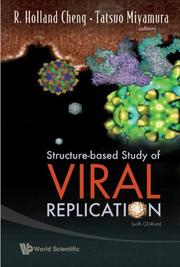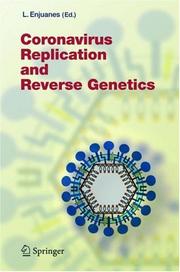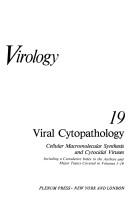| Listing 1 - 10 of 26 | << page >> |
Sort by
|
Book
ISBN: 9535110551 9535153609 Year: 2013 Publisher: IntechOpen
Abstract | Keywords | Export | Availability | Bookmark
 Loading...
Loading...Choose an application
- Reference Manager
- EndNote
- RefWorks (Direct export to RefWorks)
This book provides a collection of in-depth reviews broadly related to the mechanisms of viral replication as applied to various viruses of critical relevance for human or animal disease. Specifically, this book contains six different chapters: 1) Influenza A Virus Multiplication and the Cellular SUMOylation System; 2) West Nile Virus: Basic Principles, Replication Mechanism, Immune Response and Important Genetic Determinants of Virulence; 3) Hepatitis B Virus Genetic Diversity: Disease Pathogenesis; 4) An Overview of the Immune Evasion Strategies Adopted by Different Viruses With Special Reference to Classical Swine Fever Virus; 5) Viral Replication Strategies: Manipulation of ER Stress Response Pathways and Promotion of IRES-Dependent Translation; 6) Antiviral Replication Agents. This book is aimed at students, scholars, professors, and investigators who are peripherally related to, or somehow intrigued by, the different areas of virology covered in this book, as well as at those individuals with greater expertise and knowledge in the topics herein presented who may want up-to-date in depth reviews related to such topics.
Viruses --- Reproduction. --- Replication of viruses --- Viral replication --- Reproduction --- Medical microbiology & virology

ISBN: 1281938475 9786611938475 9812790853 9789812790859 9789812704054 9812704051 9789812704061 981270406X 9781281938473 Year: 2008 Publisher: New Jersey World Scientific
Abstract | Keywords | Export | Availability | Bookmark
 Loading...
Loading...Choose an application
- Reference Manager
- EndNote
- RefWorks (Direct export to RefWorks)
This book addresses the innovative themes in characterizing the cellular membrane platforms and intracellular networking, as well as the architectural aspects of cell compartments mediated by the entry and replication cycles of viruses. The instrumentation of modern molecular and cellular biology provides a potent array of wave packets to image, detect and manipulate major dynamics of macromolecular and subviral assemblies as in the host cellular context. The book includes case studies presented with highly coherent and structured illuminations, including microscopy, spectroscopy and scannin
Viruses --- Molecular structure. --- Structure, Molecular --- Chemical structure --- Structural bioinformatics --- Replication of viruses --- Viral replication --- Reproduction --- Reproduction.
Dissertation

Year: 2022 Publisher: Liège Université de Liège (ULiège)
Abstract | Keywords | Export | Availability | Bookmark
 Loading...
Loading...Choose an application
- Reference Manager
- EndNote
- RefWorks (Direct export to RefWorks)
The Bovine leukemia virus (BLV) is an oncogenic deltaretrovirus that induces enzootic bovine leukosis. Most of the infected bovines are asymptomatic, but after a long latency period, approximately 5% of them end up developing a leukemia/lymphoma. How the virus promotes the evolution of the disease is still not fully understood. Nevertheless, recently discovered antisense RNAs (AS1-S/L and AS2) are likely to have an important role in viral propagation and malignancy. The aim of work is to assess the involvement of antisense transcription in viral infectivity, replication and B cell homeostasis. Based on a reverse genetics approach, results show that a two base pair mutation in the promoter sequence affects negatively viral antisense transcripts levels in vitro, and that viral replication, in contrast to infectivity, requires expression of antisense RNAs in vivo.
Book
Year: 2015 Publisher: Frontiers Media SA
Abstract | Keywords | Export | Availability | Bookmark
 Loading...
Loading...Choose an application
- Reference Manager
- EndNote
- RefWorks (Direct export to RefWorks)
Understanding viral replication and pathogenicity properties in infected individuals is a major mission of animal virology. Animal models are essential to analyze the in vivo viral characteristics and to develop countermeasures against viruses. To fight against a wide variety of viruses, basic studies with specific and/ or common approaches are required. This Research Topic collects articles that describe studies on numerous virus species at various stages toward animal experiments: (i) description/evaluation/ new challenges of animal model studies; (ii) experimental material/methods for animal model studies; (iii) observations for upcoming animal model studies. Numbers of DNA and RNA viruses such as HHV-6, HPV, Ebola virus, HCV, dengue virus, HTLV-1, HIV-1, SIV, and measles virus are covered by this special issue consisting of original research, methods, review, mini-review, and opinion articles. All readers would understand, we believe and hope, that animal model studies are critical for current virology as always.
Microbiology. --- Virus diseases --- Virology --- Pathogenesis. --- Research. --- viral replication --- animal models --- viral infections --- anti-viral strategies --- viral pathogenicity
Book
Year: 2015 Publisher: Frontiers Media SA
Abstract | Keywords | Export | Availability | Bookmark
 Loading...
Loading...Choose an application
- Reference Manager
- EndNote
- RefWorks (Direct export to RefWorks)
Understanding viral replication and pathogenicity properties in infected individuals is a major mission of animal virology. Animal models are essential to analyze the in vivo viral characteristics and to develop countermeasures against viruses. To fight against a wide variety of viruses, basic studies with specific and/ or common approaches are required. This Research Topic collects articles that describe studies on numerous virus species at various stages toward animal experiments: (i) description/evaluation/ new challenges of animal model studies; (ii) experimental material/methods for animal model studies; (iii) observations for upcoming animal model studies. Numbers of DNA and RNA viruses such as HHV-6, HPV, Ebola virus, HCV, dengue virus, HTLV-1, HIV-1, SIV, and measles virus are covered by this special issue consisting of original research, methods, review, mini-review, and opinion articles. All readers would understand, we believe and hope, that animal model studies are critical for current virology as always.
Microbiology. --- Virus diseases --- Virology --- Pathogenesis. --- Research. --- viral replication --- animal models --- viral infections --- anti-viral strategies --- viral pathogenicity
Book
Year: 2015 Publisher: Frontiers Media SA
Abstract | Keywords | Export | Availability | Bookmark
 Loading...
Loading...Choose an application
- Reference Manager
- EndNote
- RefWorks (Direct export to RefWorks)
Understanding viral replication and pathogenicity properties in infected individuals is a major mission of animal virology. Animal models are essential to analyze the in vivo viral characteristics and to develop countermeasures against viruses. To fight against a wide variety of viruses, basic studies with specific and/ or common approaches are required. This Research Topic collects articles that describe studies on numerous virus species at various stages toward animal experiments: (i) description/evaluation/ new challenges of animal model studies; (ii) experimental material/methods for animal model studies; (iii) observations for upcoming animal model studies. Numbers of DNA and RNA viruses such as HHV-6, HPV, Ebola virus, HCV, dengue virus, HTLV-1, HIV-1, SIV, and measles virus are covered by this special issue consisting of original research, methods, review, mini-review, and opinion articles. All readers would understand, we believe and hope, that animal model studies are critical for current virology as always.
Microbiology. --- Virus diseases --- Virology --- viral replication --- animal models --- viral infections --- anti-viral strategies --- viral pathogenicity --- Pathogenesis. --- Research.
Book
ISBN: 3540518959 0387518959 9783540518952 9780387518954 3642752209 3642752187 Year: 1990 Volume: 157 Publisher: Berlin: Springer,
Abstract | Keywords | Export | Availability | Bookmark
 Loading...
Loading...Choose an application
- Reference Manager
- EndNote
- RefWorks (Direct export to RefWorks)
Retroviruses --- Retrovirussen --- Rétrovirus --- Retroviridae --- Virus Replication --- Physiology --- Virus Replication. --- Physiology. --- Retroviruses. --- Viruses --- Replication, Virus --- Replications, Virus --- Virus Replications --- DNA Replication --- Replication of viruses --- Viral replication --- Reproduction --- C-type RNA viruses --- Leukemogenic viruses --- Leukoviruses --- Oncornaviruses --- Oncoviruses --- RNA tumor viruses --- Oncogenic viruses --- RNA viruses --- Reproduction. --- physiology. --- Viral Replication --- Replication, Viral --- Replications, Viral --- Viral Replications --- Viral Replication Compartments --- physiology

ISBN: 128030491X 9786610304912 3540267654 3540214941 364205997X Year: 2005 Publisher: Berlin ; New York : Springer,
Abstract | Keywords | Export | Availability | Bookmark
 Loading...
Loading...Choose an application
- Reference Manager
- EndNote
- RefWorks (Direct export to RefWorks)
Coronaviruses are the RNA viruses with the largest genome known to date (27 to 32 kb). Members of this virus family affect most domestic animal species, causing important socio-economical losses, and also infect humans. Human coronaviruses were known to cause the winter common cold, a mild infection without important pathological consequences except in immuno-compromised patients. Recently, two new human coronaviruses have emerged, one causing the Severe and Acute Respiratory Syndrome (SARS) that infected more than 8000 individuals, leading to more than 800 deaths in 32 countries. This epidemic mobilized the World Health Organization, which launched travel restrictions to certain parts of the world for the first time in the last 50 years. The fact that coronaviruses, as many other viruses, crossed the species barrier to infect humans has posed a serious challenge to scientists involved in animal and human health. Control of coronavirus-induced diseases can only be the consequence of research on virus molecular biology and pathogenesis. This book contains information on virus genome structure, mechanism of replication and transcription, and the development of tools that make possible reverse genetic studies to understand virus-host interactions and the molecular basis of virus pathogenesis. The book also provides essential information for the development of classical and recombinant vaccines to control coronavirus infections.
Coronaviruses. --- Viral genetics. --- Virus genetics --- Viruses --- Microbial genetics --- Common cold viruses --- Coronaviridae --- Nidoviruses --- Genetics --- Medical virology. --- Virology. --- Medical microbiology --- Virology --- Virus diseases --- Coronavirus --- Virus Replication. --- genetics. --- Replication, Virus --- Replications, Virus --- Virus Replications --- DNA Replication --- Viral Replication --- Replication, Viral --- Replications, Viral --- Viral Replications --- Viral Replication Compartments --- Microbiology
Book
ISBN: 0948601108 9780948601101 Year: 1987 Publisher: Cambridge: Company of biologists,
Abstract | Keywords | Export | Availability | Bookmark
 Loading...
Loading...Choose an application
- Reference Manager
- EndNote
- RefWorks (Direct export to RefWorks)
Virus Replication --- Genes, Viral --- Viral Genes --- Gene, Viral --- Viral Gene --- Genome, Viral --- Viral Replication --- Replication, Viral --- Replication, Virus --- Replications, Viral --- Replications, Virus --- Viral Replications --- Virus Replications --- Viral Replication Compartments --- DNA Replication --- Virus replication --- DNA replication --- DNA viruses --- Genomes --- Viruses --- Genes --- Viral

ISBN: 0306416980 9780306416989 1461357020 1461517451 Year: 1984 Publisher: New York (N.Y.) : Plenum press,
Abstract | Keywords | Export | Availability | Bookmark
 Loading...
Loading...Choose an application
- Reference Manager
- EndNote
- RefWorks (Direct export to RefWorks)
DNA viruses. --- Host-virus relationships. --- Pathology, Cellular. --- Viruses --- Reproduction. --- Cells --- Replication of viruses --- Viral replication --- Reproduction --- Cellular pathology --- Cytopathology --- Pathology --- Cytodiagnosis --- Relationships, Host-virus --- Virus-host relationships --- Host-parasite relationships --- pathology. --- pathogenicity. --- Host-virus relationships --- Pathology, Cellular --- pathology --- pathogenicity
| Listing 1 - 10 of 26 | << page >> |
Sort by
|

 Search
Search Feedback
Feedback About UniCat
About UniCat  Help
Help News
News